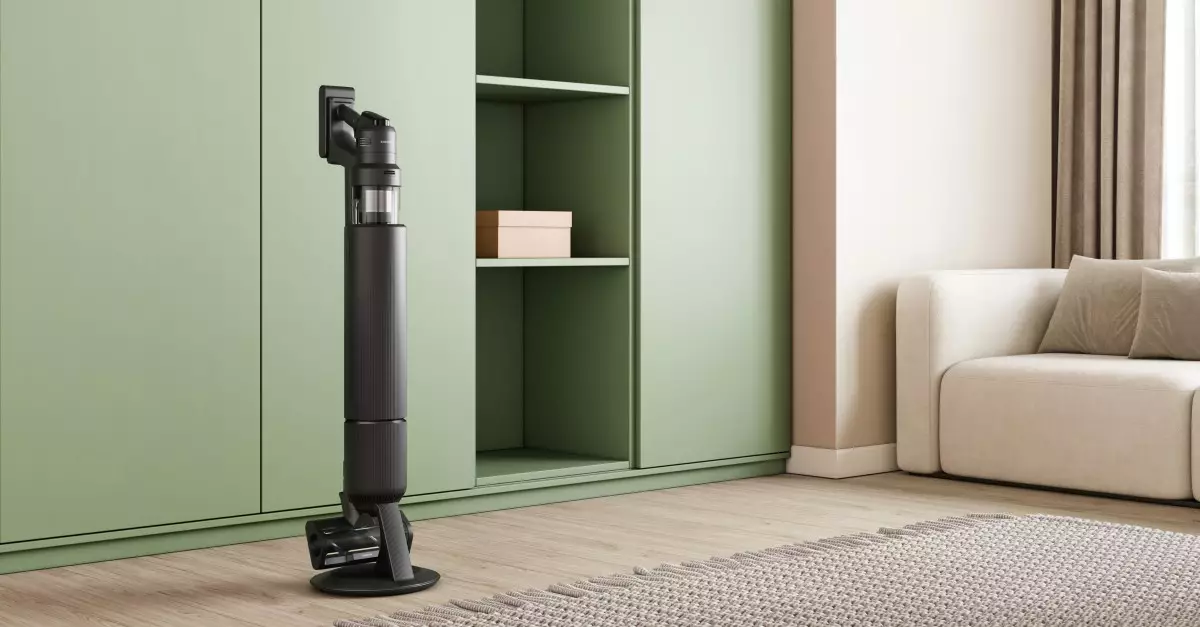In a world consistently inundated with notifications and alerts, remaining connected during various household tasks can be quite the challenge. Often, people find themselves engrossed in chores—like vacuuming or doing laundry—only to miss crucial calls or messages that could have been answered with a simple glance at their phone. Samsung’s latest innovations, notably the Bespoke AI Jet Ultra vacuum and the Bespoke AI Laundry Vented Combo washer/dryer, have emerged not merely as home cleaning devices but as integrated communication hubs that promise to redefine how we interact with our surroundings.
The introduction of an LCD display on the Bespoke AI Jet Ultra isn’t merely a feature; it presents an elevation of what we expect from our home appliances. For $1,099, this cordless vacuum doesn’t just boast impressive 400AW suction power and a 100-minute battery life; it also keeps users updated with incoming calls and texts, allowing them to stay connected without the hassle of constantly checking their devices. Similarly, the washing machine-dryer combo, priced at $3,099, allows users to attend to their laundry while effortlessly managing their communications.
A Seamless Integration of Functionality
Samsung’s commitment to smart technology underscores how essential connectivity has become in our daily routines. The integration of these touchscreens into essential appliances opens up an array of possibilities, from scheduling wash cycles to receiving notifications when cycles are complete. The capability to answer phone calls directly from the built-in 7-inch LCD screen is more than just a luxury; it transforms the humble laundry room into a space of productivity. You no longer need to rush to your phone in another room; instead, you can engage in basic phone conversations while keeping your hands free.
This integration isn’t limited to simply enabling calls. Numerous Samsung appliances, such as smart fridges and wall ovens, feature similar touchscreen interfaces, creating an interconnected ecosystem that simplifies kitchen management. From the ability to identify ingredients visually through AI-powered cameras to exporting cooking instructions to different appliances, these screens enhance efficiency in multiple aspects of daily life. Imagine following a recipe seamlessly while simultaneously using your smart fridge to check for additional ingredients.
The Challenges of Smart Appliance Technology
However, it is crucial to critically examine the implications of this trend toward integrating screens within every conceivable appliance. While these innovations are undeniably impressive and potentially life-enhancing, the question arises: are we creating a dependency on screens that may not be necessary? This trend of embedding touchscreens into everything, from washing machines to refrigerators, may risk overwhelming users and lead to obsolescence. What happens when the technology you rely on fails or becomes outdated? A touch interface could easily fall victim to wear and tear or accidental damage that a traditional switch or knob would typically withstand more robustly.
Moreover, there looms the concern of advertising encroaching upon what should be functional spaces. Currently, Samsung’s appliances haven’t incorporated ads, but as seen with other smart devices, there’s potential for monetization through advertisements widely seen in the realm of smart displays. The thought of cooking instructions being interrupted by a pop-up ad feels counterintuitive, contributing to unnecessary distractions in an environment meant for focus and productivity.
A Vision for the Future of Smart Homes
Samsung’s push for an interconnected home, manifesting through its AI Home-control panels, is part of a broader vision for technology softly aiding in everyday tasks. The SmartThings platform allows users to manage other connected home devices smoothly, adding layers of convenience to daily routines. Yet, it’s also vital for consumers and manufacturers to seriously consider where this journey is leading. The goal should center around enhancing quality of life without making technology an overpowering presence in our spaces.
One cannot overlook the excitement that comes from remarkably innovative practices that promise a brighter, more seamless future. However, the home should remain a sanctuary designed for comfort rather than a stage for constant technological engagement. Balancing practicality with smart features is the ultimate challenge—ensuring that technologies serve to simplify our lives rather than complicate them further.
Indeed, as Samsung and other companies continue to push the boundaries of smart technology, we must consider functionality, user experience, and potential pitfalls, all while embracing the exciting prospects these advances hold for making our homes smarter and our lives more connected.


Leave a Reply